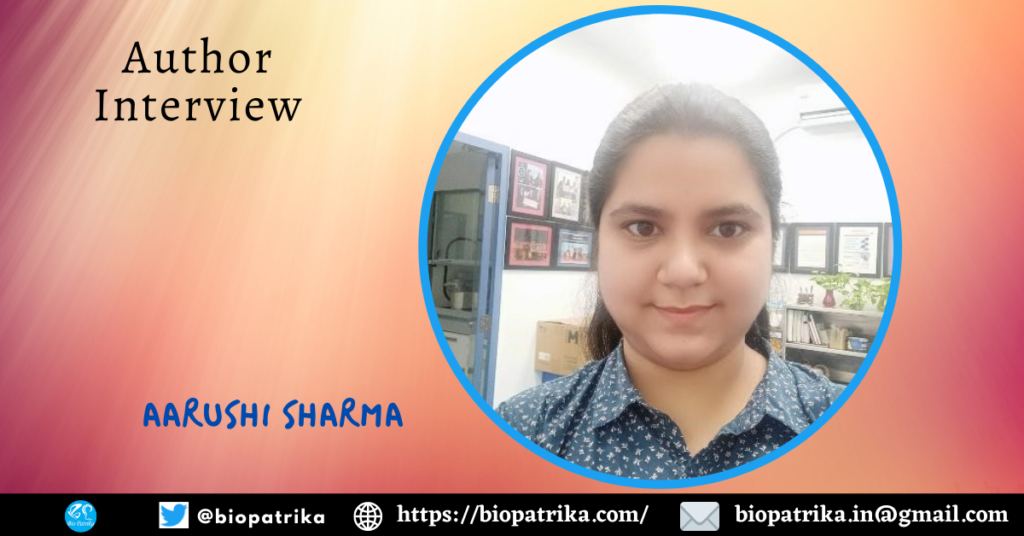About author: Aarushi Sharma is pursuing her research from the Department of Textile Technology at the Indian Institute of Technology, Delhi, India. She completed her B. Tech and M. Tech. in Biotechnology from Banasthali University, Rajasthan. During her master’s project, she developed interest in the field of 3D-bioprinting. After completing her master’s project, she continued her research by joining Regenerative Engineering Lab. Her research interest lies in development of cell-friendly biopolymers to develop anatomically relevant constructs using 3D bioprinting.
How would you explain your research outcomes to the non-scientific community?
Since long time many scientists around the world are trying to develop engineered liver. But there are many challenges in this task. It is extremely difficult to replicate complex architecture of liver. We need a material which can provide some signals to the cells to regenerate liver in laboratory condition (outside of body).

We have mixed silk protein with decellularized Liver matrix. Then by 3D printing we created a special geometry for liver cell growth. Silk- Decellularized Liver matrix bioink scaffolds provided a conducive microenvironment for maintaining differentiation and functions of hepatic cells through the activation of specific signaling pathways. These liver-specific scaffolds have immense potential for 3D printing applications in liver tissue engineering.
How do these findings contribute to your research area?
We mixed Silk fibroin protein and decellularized Liver matrix in a manner that we can use this as bioink for 3D printing or 3D bioprinting. This special bioink provided the hepatocytes with the desired microenvironment which is quite similar to the liver inside human body.
What was the exciting moment during your research?
During the study, there were many exciting moments for me. Here are the two most memorable moments, which I would like to share. First is the decellularization of the Rat liver. Although, in our lab, we have successfully standardized the protocol for cornea decellularization by using the perfusion bioreactor. But with Rat liver we did a lot of hit and trial with different decellularization techniques. Each of the decellularization techniques showed a remaining DNA content, which could affect our study. Then, our collaborators, Preety and Dr Savneet Kaur (ILBS), standardized the decellularization for the whole Rat liver by passing the detergents through portal veins.
The second such moment was while we were facing challenges with fabrication of a physiologically stable 3D printed Silk- Decellularized Liver matrix. We had to use different crosslinking agents to achieve it. The increase in the crosslinker (Mushroom Tyrosinase) concentration helped us to overcome this drawback.
What do you hope to do next?
In general, hepatocytes tend to lose their primary characteristics, like cell shape and function, when cultured in monolayer in tissue culture petri dish. Through this preliminary study we have developed the better understanding of the primary Mice Hepatocytes and Human liver hepatoma cells with the 3D-printed Silk- Decellularized Liver matrix. Based on these exciting results, we are planning to further the research by encapsulating the Hepatocytes into optimized Silk- Decellularized Liver matrix composition.
Where do you seek scientific inspiration from?
Most of the scientific inspiration comes from the literature. For me personally, genesis of the idea also comes by continuously interacting with researchers involved in the study because every person processes the same knowledge with different understanding. Moreover, while reading statistics of different diseases, I came to know about increase in chronic liver diseases globally. Approx. 32% of Indian population suffers chronic liver disease due to Non-alcoholic fatty liver. The prevalence of the disease increases in obese and diabetic patients. Other causes of chronic liver disease are Hepatitis and liver transplant. In India, nearly 2,00,000 individuals die because of liver diseases, out of which 50,000 people require liver transplant. So far, there are only 2000 liver transplants happening in India each year. The immense difference between available liver tissues for transplant and number of patients in need for liver transplant is very wide. Therefore, a need for a successful liver tissue engineering technique arises. By developing the Silk- Decellularized Liver matrix bioink for development of artificial liver, we aim to save millions of lives globally.
How do you intend to help Indian science improve?
My first experience with the field of tissue engineering was at a very young age of 5 when my elder brother had an artificial nerve implanted into his body. At that time, the field of tissue engineering was emerging globally. Still, we were able to procure the implant for his treatment from outside India. Whereas India is still struggling to develop a successful protypes. The journey from prototype to product is very strenuous in India. In future, I would like to bridge the gap between a protype and product.
Reference
Aarushi Sharma, Preety Rawal, Dinesh M Tripathi, Dashrath Alodiya, Shiv K Sarin, Savneet Kaur, and Sourabh Ghosh. Upgrading Hepatic Differentiation and Functions on 3D Printed Silk–Decellularized Liver Hybrid Scaffolds. ACS Biomaterials Science & Engineering 2021 7 (8), 3861-3873. DOI: 10.1021/acsbiomaterials.1c00671
Edited by: Pratibha Siwach
